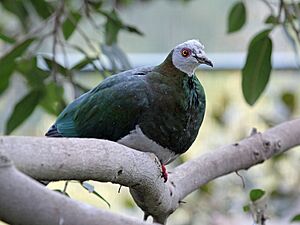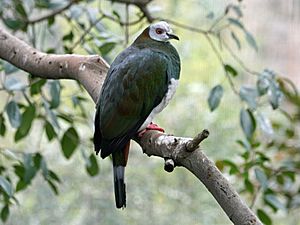White-bellied imperial pigeon facts for kids
Quick facts for kids White-bellied imperial pigeon |
|
|---|---|
 |
|
| At San Diego Zoo | |
| Conservation status | |
| Scientific classification | |
| Genus: |
Ducula
|
| Species: |
forsteni
|
| Synonyms | |
|
|
The white-bellied imperial pigeon (Ducula forsteni) is a type of bird in the pigeon family. It was first described in 1854 by a French bird expert named Charles Lucien Bonaparte. This pigeon lives only in Indonesia. You can find it on islands like Sulawesi, Buton, Taliabu, Togian, and Peleng.
These pigeons like to live in thick forests and woodlands. They also live in hill forests. It is a large pigeon with a long tail. It grows to be about 42.5 to 51.5 centimeters (16.7 to 20.3 inches) long. On average, it weighs around 510 grams (18 ounces).
Male pigeons are mostly green. They have pale-grey heads and bellies. Their vents (underparts) are chestnut colored. They also have a pale grey band on their tail. Around their eyes, they have a red ring. Female pigeons look almost the same. However, their grey areas are a bit darker.
The white-bellied imperial pigeon eats fruit. The International Union for Conservation of Nature (IUCN) lists it as a least concern species. This means it is not currently in danger of disappearing. This is because it lives in a large area. Also, its population is not dropping quickly. However, its numbers are going down because its home is being destroyed.
Contents
How It Got Its Name
The first white-bellied imperial pigeons were found in May 1840. A Dutch naturalist named Eltio Alegondas Forsten collected them. He found them near Lake Tondano in northern Sulawesi. He thought they were a new species and called them Columba taeniura.
Later, some of these pigeons were sold to a taxidermist. Then, a Dutch zoologist named Coenraad Jacob Temminck bought them. He decided to officially describe the new species. He wanted to name it after Forsten, the person who found it. But there was a mistake in the name when it was written down. So, it was first called Columba Forsterii.
In 1854, Charles Lucien Bonaparte corrected the name. He called it Hemiphaga forsteni. This name is now the correct one for the species. The pigeon's scientific name, forsteni, honors Eltio Alegondas Forsten. The first part of its scientific name, Ducula, comes from a Nepali word for imperial pigeons.
The official common name for this bird is white-bellied imperial pigeon. Other names it has been called include Celebes imperial pigeon and emerald imperial pigeon.
Pigeon Family Tree
The white-bellied imperial pigeon is one of 41 species in the Ducula genus. This group includes many imperial pigeons. They live in places from southern Asia to New Guinea, Australia, and the Pacific Islands.
This pigeon is closely related to the pink-bellied imperial pigeon. Sometimes, people even thought they were the same species. These two birds are part of a group with the Mindoro imperial pigeon and the Grey-headed imperial pigeon. All four of these species have sometimes been placed in their own genus called Zonophaps.
What It Looks Like
The white-bellied imperial pigeon is a very large bird. It has clear markings and a long tail. It measures about 42.5 to 51.5 centimeters (16.7 to 20.3 inches) long. It weighs around 510 grams (18 ounces) on average.
Its upper body and chest are mostly dark green. They have a shiny bronze-red color, especially on their back. The head is pale grey, becoming white on the forehead and throat. The chest and belly are white, sometimes with a pink or cream tint. The feathers under its tail are dark chestnut. The outer part of its tail has a pale grey band in the middle.
Its eyes are yellow or orange. It has a darker red or orange ring around its eyes. Its beak is black, and it has feathers on the top part. Its feet are purplish. Female pigeons look almost exactly like males. However, the grey parts of their feathers are a bit darker.
This pigeon can sometimes be confused with the grey-headed imperial pigeon. But the grey-headed one is smaller. It also has a thinner and darker tail band. Its upper body and head are more evenly grey. It does not have green on its chest or white on its belly. Also, the skin around its eyes is greenish, not red.
The green imperial pigeon might also be confused with it. But the green imperial pigeon has a wine-grey head, neck, chest, and belly. It has chestnut color on its nape (back of the neck). It also does not have a tail band.
What It Sounds Like
The white-bellied imperial pigeon's call is a short, low sound. It sounds like whuu-whooo....whuu-whooo. Each sound lasts about 0.2 to 0.3 seconds. The second sound is lower and stronger than the first. Sometimes, they make a three-note call. The third note is like the second one. They usually call before sunrise and after midday.
Where It Lives
The white-bellied imperial pigeon lives only in Indonesia. It can be found on Sulawesi, Buton, Taliabu, Togian, and Peleng. It lives in old-growth forests and thick regrown forests. It can be found in mountains or along the coast. It also lives in small areas of hill forest.
These birds live at heights from 150 to 2,200 meters (490 to 7,220 feet) above sea level. But they are most common at heights between 800 and 1,600 meters (2,600 and 5,200 feet).
How It Behaves
You usually see the white-bellied imperial pigeon alone or in pairs. But sometimes, small groups gather near fruit trees. It is easiest to spot them flying high above the trees. You might also see them in tall trees or smaller trees at the edge of the forest. Their flight is strong, with slow and deep wingbeats.
What It Eats
The white-bellied imperial pigeon eats only fruit. Groups of up to 30 birds can gather at trees that are full of fruit, especially fig trees.
Its Status
The International Union for Conservation of Nature (IUCN) lists the white-bellied imperial pigeon as a least concern species. This means it is not currently at high risk of extinction. This is because it lives in a large area. Also, its population is not dropping quickly.
However, its numbers are thought to be going down. This is mainly because its natural home is being destroyed. It is fairly common on Sulawesi. In some places, it is very common. But it is not common on Taliabu.



